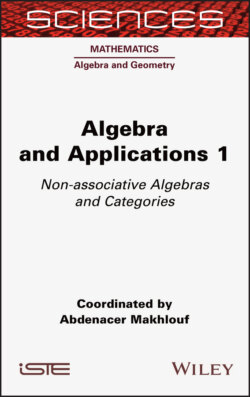Читать книгу Algebra and Applications 1 - Abdenacer Makhlouf - Страница 34
2.3.2. Isotropic Hurwitz algebras
ОглавлениеAssume now that the norm of a Hurwitz algebra (, ∙, n) represents 0. That is, there is a non-zero element such that n(a) = 0. This is always the case if and is algebraically closed.
With a as above, take such that , so that n(a ∙ b, 1) = 1. Also n(a ∙ b) = n(a)n(b) = 0. By the Cayley–Hamilton equation, the non-zero element e1 := a ∙ b satisfies , that is, e1 is an idempotent. Consider too the idempotent , and the subalgebra generated by e1. (1= e1 + e2).
For any and, as and , we conclude that x ∙ e1 = e2 ∙ x, and in the same way, x ∙ e2 = e1 ∙ x, for any .
But x = 1 ∙ x = e1 ∙ x + e2 ∙ x, and e2 ∙ (e1 ∙ x)= (1 − e1) ∙ (e1 ∙ x) = 0 = e1 ∙ (e2 ∙ x). It follows that splits as with
For any , n(u) = n(e1 ∙ u) = n(e1)n(u) = 0, so , and too, are totally isotropic subspaces of paired by the norm. In particular, , and this common value is either 0, 1 or 3, depending on being 2, 4 or 8. The case of = 0 is trivial, and the case of = 1 is quite easy (and subsumed in the arguments below). Hence, let us assume that is a Cayley algebra (dimension 8), so .
For any and , using [2.5] we get
Hence, is orthogonal to both and , so it must be contained in . Also .
Besides,
so that , and also . But for any and , we have
and the analogues for v ∙ u. We conclude that
Now, for linearly independent elements , let with n(u1, v) ≠ 0 = n(u2, v). Then the alternative law gives (u1 ∙ u2)∙ v = −(u1 ∙ v)∙ u2 +u1 ∙ (u2 ∙ v + v ∙ u2) = −n(u1, v)u2 ≠ 0, so that u1 ∙ u2 ≠ 0. In particular, , and the same happens with .
Consider the trilinear map:
This is alternating because x∙2 = 0 for any by the Cayley–Hamilton equation, and n(x ∙ y, y) = −n(x, y ∙ y) = 0. It is also non-zero, because , so that .
Fix a basis {u1, u2, u3} of with n(u1 ∙ u2, u3) = 1 and take v1 := u2 ∙ u3, v2 := u3 ∙ u1, v3 := u1 ∙ u2. Then {v1, v2, v3} is the dual basis in relative to the norm, and the multiplication of the basis {e1, e2, u1, u2, u3, v1, v2, v3} is completely determined. For instance, v1 ∙ v2 = v1 ∙ (u3 ∙ u1) = −u3 ∙ (v1 ∙ u1) = −u3 ∙ (−n(v1, u1)e2) = u3, …
The multiplication table is given in Figure 2.1.
The Cayley algebra with this multiplication table is called the split Cayley algebra and denoted by . The subalgebra spanned by e1, e2, u1, v1 is isomorphic to the algebra of 2 × 2 matrices.
We summarize the above arguments in the next result.
THEOREM 2.2.– There are, up to isomorphism, only three Hurwitz algebras with isotropic norm: × , and .
COROLLARY 2.3.– The real Hurwitz algebras are, up to isomorphism, the following algebras:
– the classical division algebras ℝ, ℂ, ℍ, and ;
– the algebras ℝ × ℝ, and .
Figure 2.1. Multiplication table of the split Cayley algebra
PROOF.– It is enough to take into account that a non-degenerate quadratic form over ℝ is either isotropic or definite. Hence, the norm of a real Hurwitz algebra is either isotropic or positive definite (as n(1) = 1). □
